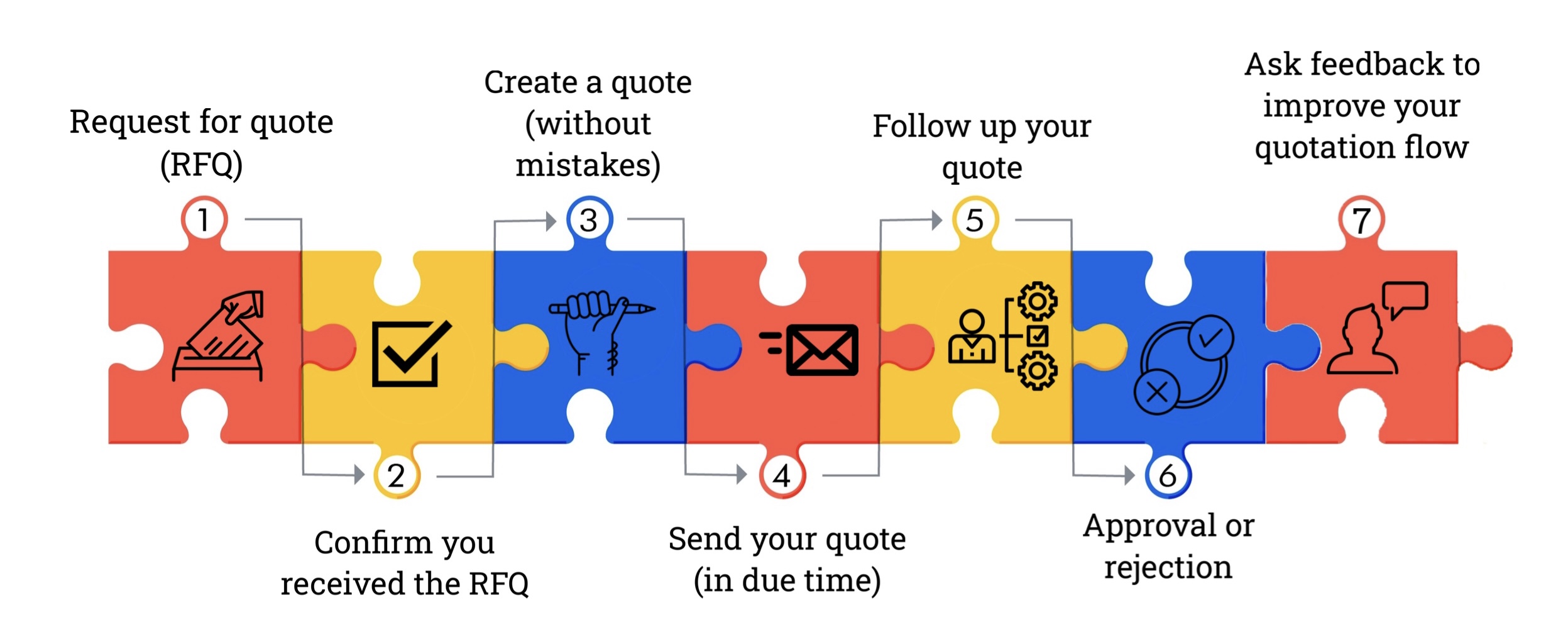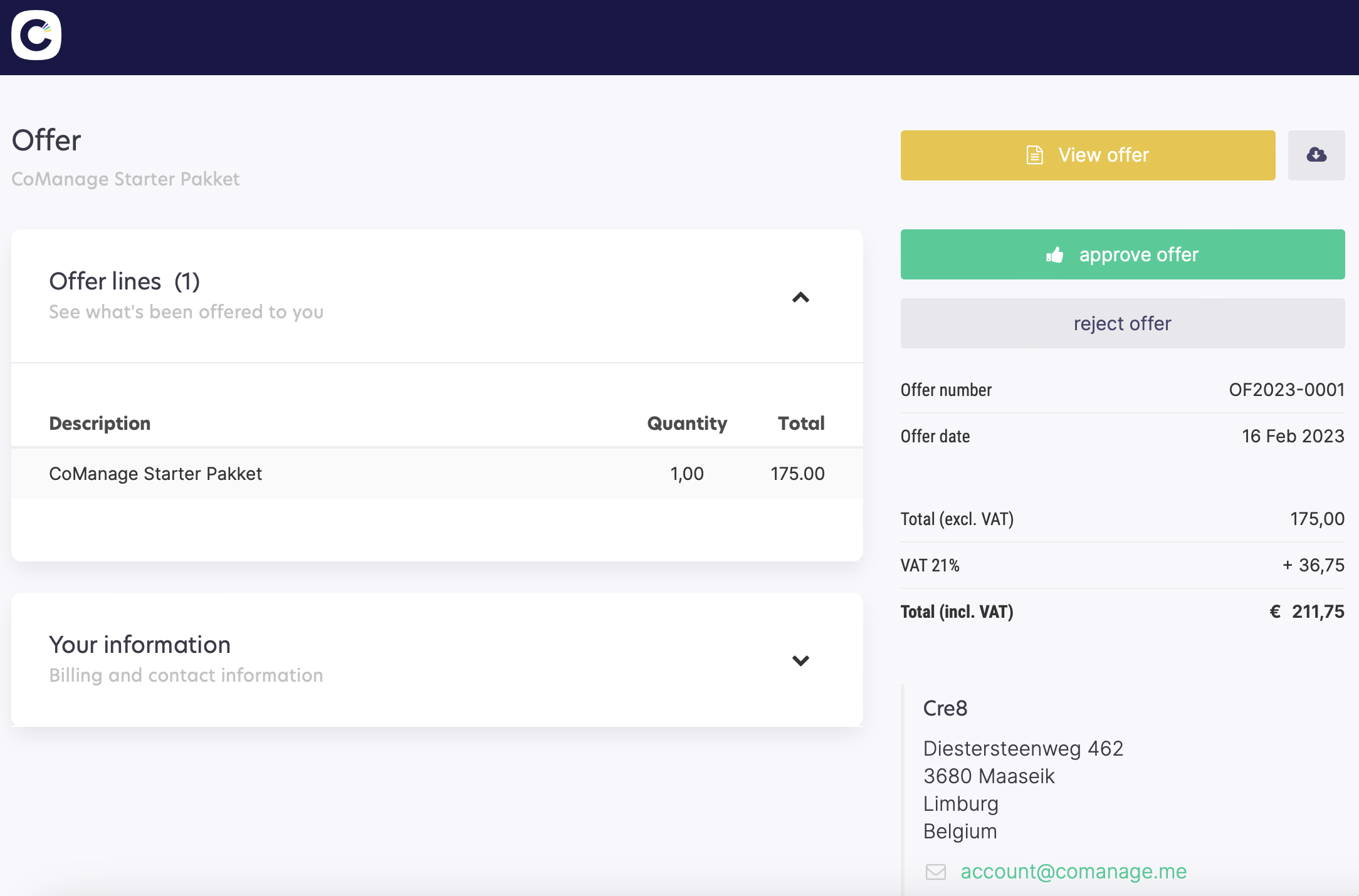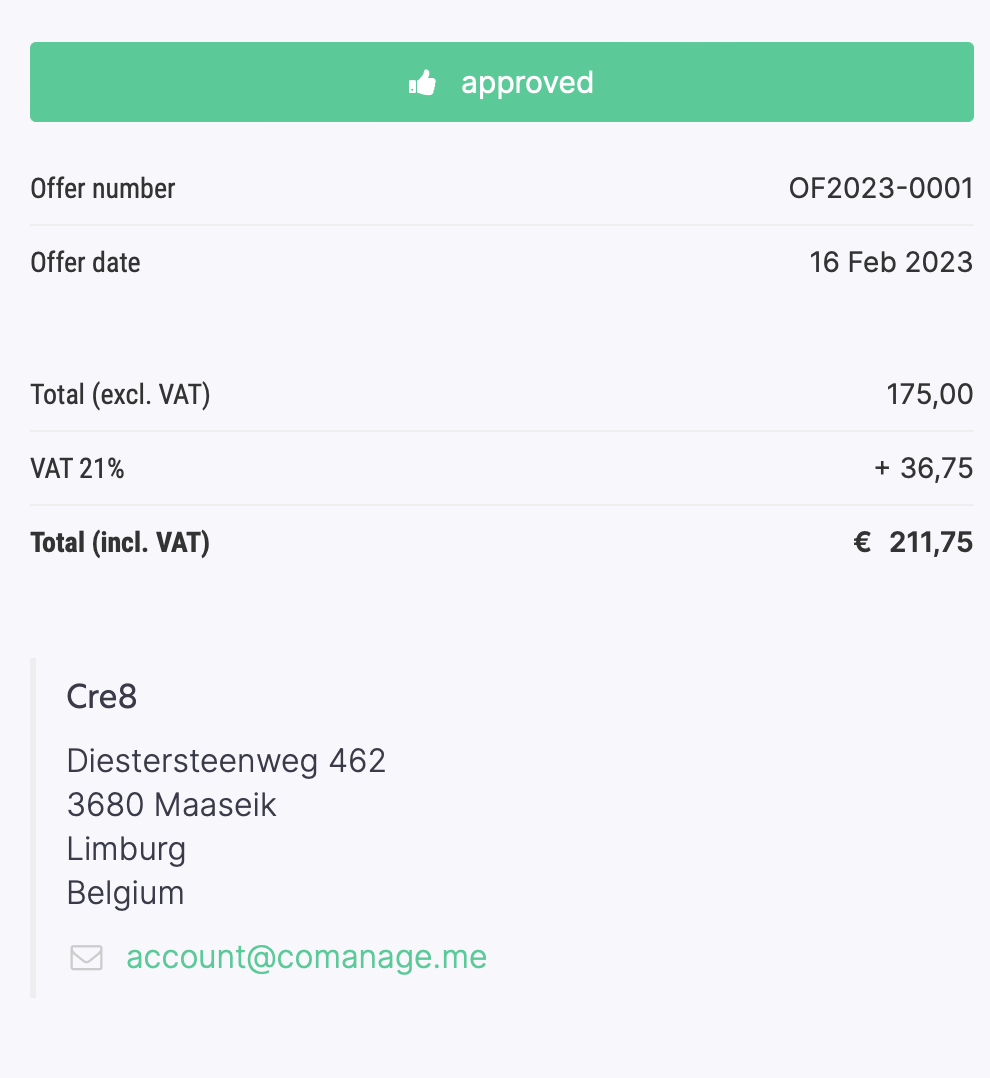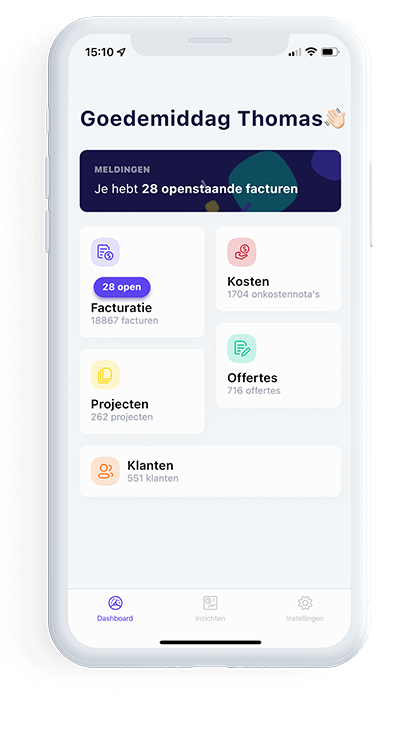
The quoting process: 7 simple steps to avoid sales leakage
Do business quotations take much of your time without resulting in sales? Then it’s about time you implement a quoting process or optimise your quotation flow. This sounds complicated, but it's simple and can even move the needle for small businesses and solopreneurs.
Key takeaways
The quoting process involves 7 steps you need to complete in sequence.
Creating a quote is only 1 of them.
If you apply a quoting procedure systematically, you will reduce the risk of sales leakage.
Although business processes are typical for enterprises, they can be useful for companies of all sizes.
Good quotation software speeds up implementing the process for an optimal sales flow.
Table of contents
What is a quoting process, anyway?
A quoting process contains 7 steps. It begins with a request for a quote and ends with feedback. The end goal is to increase the success rate of quotation approvals.
The advantage of treating quotes as a business process immediately becomes clear when we compare it with a situation you will probably recognise.
If you open a box of Lego, or IKEA furniture, you can do two things:
Follow the steps of the manual.
Follow your gut feeling and figure out the puzzle yourself.
The same applies to your sales flow.
You have a clear goal in mind (sales) and you can try to achieve it with or without following a blueprint.
A business process simplifies things. Follow the playbook and you will reduce the risk of, for example, making mistakes in your quotes. It also prevents you from missing vital steps towards generating more revenue.
The 7 steps of an efficient quoting flow
Before we get into the specifics, have a look at the scheme below with the 7 steps of a quoting process.

Let’s examine each step carefully and highlight the quick wins to improve your sales process.
#1 Quotation request
People and businesses want to buy services or goods to fulfil their needs. One thing they want to know in advance is how much it will cost.
To get the answer, they will ask you to send a quote in one of the following ways:
send or publish a request for a quotation
fill in a form on your site
ask you in person during an event or meeting
call you
send you a message on social media
If you don't have the patience to wait for business opportunities, you can propose to send a quote before customers ask you.
This may sound pushy, but some people can appreciate a proactive sales attitude.
#2 Confirm you have received the request for the quote
Running a business requires you to focus on 1,000 things at the same time. The needs and problems of customers, such as finding out your price, deserve your attention.
You cannot serve everybody instantly, but it is important to inform people that you received their request for a quote.
Quotations are a dialogue
Which answer do you prefer if you have a question about anything?
Silence.
I will look at it.
The second option is a sign of respect for your customers.
Besides, it's easy if you apply these simple tricks:
Set up autoresponders for web forms.
Make sure the person in charge of creating quotations knows when a request for a quote is submitted.
Micromanaging people is a bad idea. But before people turn this step into a habit, it is good to follow-up on the status of quotation requests with several team members.
Write requests in your calendar. It’s easy to promise you will send a quote. It’s equally easy to forget to actually do it.
Planning is key for any entrepreneur who wants to grow. The next step is more challenging.
#3 Create a quote
Creating a quotation is only the 3rd step of an effective quoting process. Based on your price proposal, customers will decide if ordering from you is the wisest thing to do.
Therefore, it is vital to pay attention to every detail. The last thing you want is that your quote contains errors.
Yes, preventing this takes a big chunk of your time. After all, you need to answer a lot of questions before you can consider the task done.
Have I included the 9 elements of a good quotation?
When can I deliver the goods (stock management) or services (project management)?
Are my prices profitable, correct and attractive?
Does this client deserve a discount (because they are loyal or you are running a promotional campaign)?
Whether you work as a team, it is important that the person who creates quotations has access to all the correct and updated information to create a quote.
If you want to guarantee 100% error-free quotes, you can best have them reviewed and approved before proceeding with the next step.
Pro tip: If you use a quotation tool, such as CoManage, you can speed up this daunting task. You can, for instance, duplicate a quote instead of starting from scratch.
#4 Sending your quote
The timing and the way you send your quotes can highly influence the outcome. With a couple of small tweaks, you can optimise this step.
As for timing: respect the promises you made to your customer in step 2 of the quotation procedure.
Keep track of the status of your quotations. This way, you will know exactly if you, or your team members, have sent a quote or not.
Email or snail mail are the most common and easy ways to send quotes.
You can also create online quotations for customers. These are hidden from search engines and outsiders. Only you and your customer will see it.

PRO TIP: The status of a quote is a handy visual aid to keep track of which steps you, or your sales team, have completed.

Don’t sit back and relax as many businesses do.
An effective quotation process doesn’t end with sending a quote.
#5 Follow up on quotes
Following up quotations is the next logical step. Yet, many businesses skip this. Why?
Because they have no time.
Don’t see the point (yet).
Or believe that an organised quotation administration is complicated and expensive. Well, let us tell you: it is absolutely not as you can discover here.
If you want to close more deals, this step contains golden opportunities for your business.
The good news is that they are not super complicated.
Apply our expert advice to follow up quotations.
As in all previous steps, pay attention to details, such as crafting your emails to follow up your quotes. You can now make use of the Chat-GPT integration in CoManage. It can help you write good emails for your quotes.
#6 Approval or rejection
At one point, your quotes get approved or rejected. The quotation cycle is almost finished.
Regardless of the outcome, make sure you change the status of your quote to either Approved or Rejected.


This way, you and your team can proceed with their next duties.
Ideally you can start planning tasks, required resources (people and equipment), deadlines and milestones to turn the project into your next success story.
Or you can set your warehouse in motion and pack the goods for delivery.
Pro tip: In CoManage, you can also create order bills or projects. This way, approved quotations can smoothly leave the quoting flow.
#7 Collect feedback on your quotes
Collecting feedback from your leads or customers is the last step of an effective quoting process.
You can integrate this in the previous two steps. Yet, it is worth keeping this as a separate item on your checklist.
Why is it important to collect feedback on your quotations?
Quotations are a cyclical process. They have a beginning and an end.
Along the road, you can detect leaks and prevent them in future quotes.
If your customers tell you what you can improve, or what moved the needle to choose for you, your business will grow faster.
Easily implement a quotation process
Changing your mind from creating quotes to implementing a quoting process in your business will eliminate tons of typical sales mistakes.
The step-by-step procedure will also fix the horrible phenomenon of sales leakage.
You can use the 7 steps and advice as a checklist to evaluate and improve your current sales flow.
Or you can use a powerful quotation tool that does part of the hard work for you.
If you want to experience what difference this can make for your company, click on the button below.




